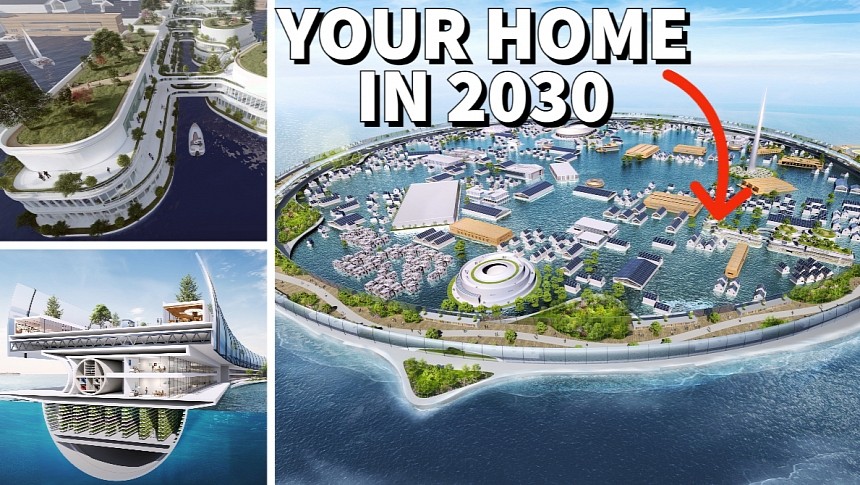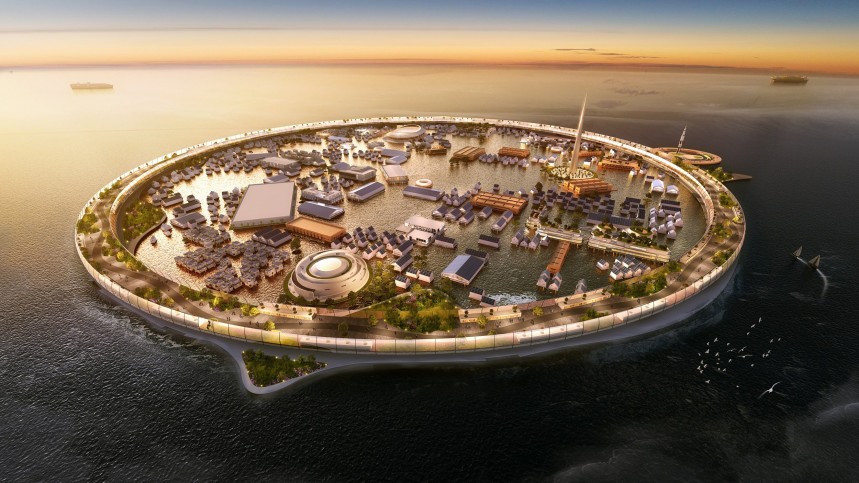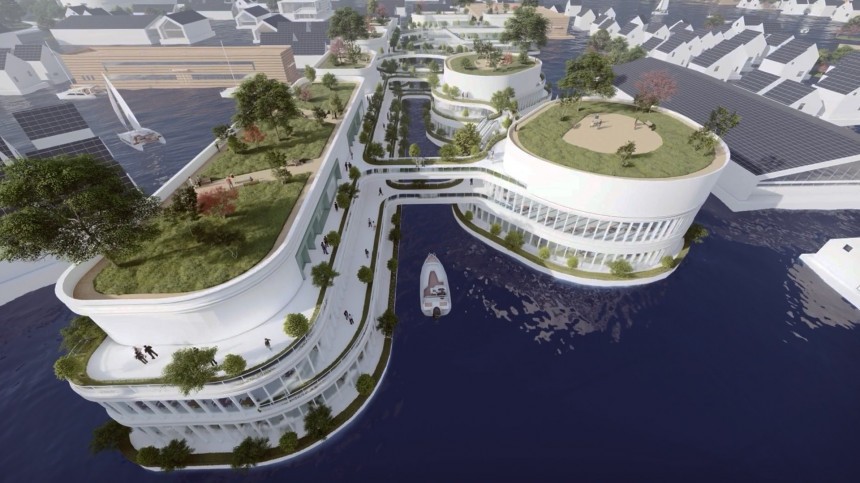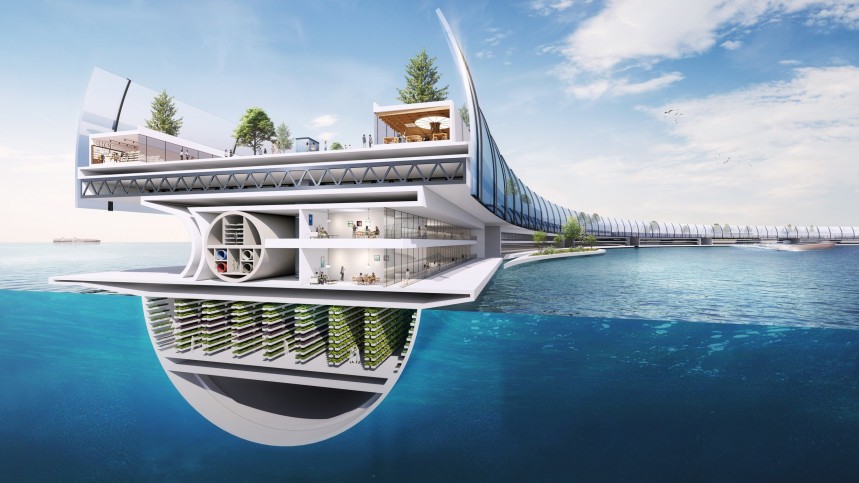Tolerance for tinfoil-cap-wearing pals is low, but planning for the worst is always smart. Climate change is not getting any better, and coastal communities are most affected by rising sea levels, so this one startup is stepping into the shoes of that ingrate tinfoil-cap-wearing pal to do some doomsday planning.
Our planet is on a crash course to extinction due to climate change, and the route there will be incredibly challenging too. Rising sea levels are just one of the dangers of rising temperatures, with experts estimating that millions from coastal communities will be displaced in the following years. One solution to this particular issue that various groups and startups are looking at is building floating cities.
Floating cities remain just a dream for the time being, but oh, what a beautiful dream they are. Most ongoing projects are on the luxurious side, selling future residences to the well-heeled with promises of a no-crime, no-currency, no-stress society where wellness and relaxation are focus points, sheltered from the outside world and the elements. We're talking about multi-million homes in the middle of the ocean, on a piece of floating concrete, unlike anything built there before, both in terms of size and technology needed to sustain life in the long term. No wonder then that there's plenty of skepticism around this type of project.
Us folk with average incomes, mortgages, kids, and what-have-you can also dream of a similar future. Japan-based maritime startup N-Ark is helping us with it, unveiling plans for a floating city they call Dogen City, a circular structure with incredible capabilities. Dogen City would serve multiple purposes all at once, including that of sheltering and offering education to victims of natural disasters and climate refugees. Which could be us, if we're lucky – if you'll allow one final joke.
Dogen City is a giant structure designed to house 40,000 people on a permanent basis: 10,000 residents and 30,000 tourists, whether for leisure, research, or, more boldly so, medical tourism. During peacetime, it would fulfill this purpose, but during wars or natural disasters, it would serve as an emergency solution due to its self-sufficiency. With its three layers and a circumference of 4 km (2.5 miles), it would offer "no-illness" neighborhoods, research centers and entertainment spaces, and protection against tsunamis.
Details on the project remain scarce right now, but the newly-founded New Ocean Consortium, which estimates a 2030 opening date, notes that health and research would be the focus points, serving as the base of a "new maritime economy." This would be achieved through the division of the City into three layers or "industries."
There's the habitable, no-illness area of public housing, which is actually a self-sustaining village carved into the ring-shaped structure. The ring also helps with protection against tsunamis, the developers say. Inside the ring, in the artificial bay, are facilities for growing food, creating energy, and waste disposal, as well as the third layer that would be equivalent to SpaceX in that it would serve as landing site for rockets. As already mentioned, if we're to dream about a future on water, we might as well go overboard with it.
The second layer is not immediately noticeable from afar because it's underwater. It's the research and educational area situated below the waterline so as to take advantage of the cooling capabilities of the ocean, thus reducing energy consumption. Also here is city management, whatever that might mean in the future.
N-Ark puts a great deal of emphasis on mental and physical health, both for the residents and daytime visitors and tourists. Daily telemed consultations using sensors, genome analysis, and blood samples would be used preventively, while advanced robotic surgery and drug research would help with treatment.
"The concept is medicine, food, and housing are the same source," N-Ark says. That source is the ocean, which also helps grow food and harvest energy, both solar and from the waves. Dogen City would use an innovative cultivation technology using seawater, with developers estimating an annual production of 7,000 tons of food. Further estimates include the generation of 22,265,000 kW of power, but also a 2 million liter (530,000 gallons) of annual water consumption per year and 3,288 tons of annual garbage.
For whatever reason, this is where N-Ark stops with the numbers. They don't mention a price for a home on Dogen City or even an estimated budget for the construction, which makes the 2030 estimated timeline even sketchier than it might have seemed at first. A project of this scale and with such ambitious goals is theoretically possible, but putting it in use within seven years feels ambitious at best, especially in the challenging context where there is no precedent for anything like it.
Then again, who are we to interfere with dreams?
Floating cities remain just a dream for the time being, but oh, what a beautiful dream they are. Most ongoing projects are on the luxurious side, selling future residences to the well-heeled with promises of a no-crime, no-currency, no-stress society where wellness and relaxation are focus points, sheltered from the outside world and the elements. We're talking about multi-million homes in the middle of the ocean, on a piece of floating concrete, unlike anything built there before, both in terms of size and technology needed to sustain life in the long term. No wonder then that there's plenty of skepticism around this type of project.
Us folk with average incomes, mortgages, kids, and what-have-you can also dream of a similar future. Japan-based maritime startup N-Ark is helping us with it, unveiling plans for a floating city they call Dogen City, a circular structure with incredible capabilities. Dogen City would serve multiple purposes all at once, including that of sheltering and offering education to victims of natural disasters and climate refugees. Which could be us, if we're lucky – if you'll allow one final joke.
Details on the project remain scarce right now, but the newly-founded New Ocean Consortium, which estimates a 2030 opening date, notes that health and research would be the focus points, serving as the base of a "new maritime economy." This would be achieved through the division of the City into three layers or "industries."
There's the habitable, no-illness area of public housing, which is actually a self-sustaining village carved into the ring-shaped structure. The ring also helps with protection against tsunamis, the developers say. Inside the ring, in the artificial bay, are facilities for growing food, creating energy, and waste disposal, as well as the third layer that would be equivalent to SpaceX in that it would serve as landing site for rockets. As already mentioned, if we're to dream about a future on water, we might as well go overboard with it.
N-Ark puts a great deal of emphasis on mental and physical health, both for the residents and daytime visitors and tourists. Daily telemed consultations using sensors, genome analysis, and blood samples would be used preventively, while advanced robotic surgery and drug research would help with treatment.
"The concept is medicine, food, and housing are the same source," N-Ark says. That source is the ocean, which also helps grow food and harvest energy, both solar and from the waves. Dogen City would use an innovative cultivation technology using seawater, with developers estimating an annual production of 7,000 tons of food. Further estimates include the generation of 22,265,000 kW of power, but also a 2 million liter (530,000 gallons) of annual water consumption per year and 3,288 tons of annual garbage.
Then again, who are we to interfere with dreams?











